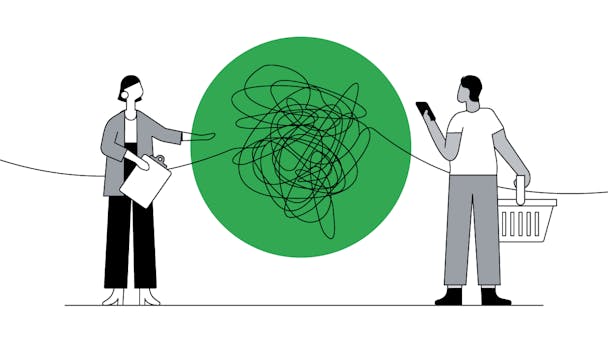How marketers can make an impact in the ‘messy middle’
Google’s researchers decode how people make decisions and navigate the messy middle of the online purchase journey, in a four-part video series. Read on for a full recap.

Marketing in the messy middle / Google
The internet is a place where people compare almost everything before they buy. It’s a complex task for marketers to ensure their brand shows up and stands out in a sea of abundant product choice and almost limitless information. It seems daunting, but there is a path through the ‘messy middle’ - and it starts with getting a deeper understanding of how consumers actually decide what to buy.
Building on three years of research, ‘Marketing in the messy middle’ is the new and next iteration of research from Google and The Behavioral Architects - helping brands understand how they can use behavioral science insights that shape consumer decision-making in their own campaigns and content.
A video series from The Drum and Google breaks down each chapter of the new report into four episodes: behaviors, search, confidence and shopping, as researchers all from its Market Insights team in EMEA explain the findings to make sense of what goes on in the messy middle and what marketers can do about it.
Episode 1: Behaviors
In episode one, Jonny Protheroe, head of Market Insights EMEA at Google, shares a key insight that inspired the research and explains how it has evolved from ‘what’ to ‘how’ - how to use the insights to create better experiences for consumers and more successful campaigns for brands.
“Between a trigger to becoming in-market, and an eventual purchase, consumer behavior is extremely messy and non-linear,” he explains. “But when we looked more closely we found that really there are just two distinct mindsets at play. Consumers often move back and forth between exploring (an expansive activity) and evaluating (a reductive activity) multiple times before eventually exiting the messy middle and making a purchase.”
Key takeaways for brands:
- Brands can win a share of preference simply by showing up - ensure your brand has broad presence and campaign coverage in the messy middle
- Close the gap between trigger and purchase - by creating ads that draw people to your properties and providing helpful content that meets their information needs
- Craft compelling propositions, informed by behavioral science, that address the underlying drivers of what people choose to buy, and from where.
Episode 2: Search
In episode two, Emily Allen explores the starting point for where the different mindsets come into play: search.
“By design, Google Search is a place where we can quickly and easily scan and review product propositions from multiple brands in one place,” said Allen. “This presents marketers with an opportunity to connect with consumers. There’s value in simply showing up when shoppers have a choice to make - and we saw through our experiments that by intelligently and responsibly optimizing Search Ads and propositions with behavioral science, we have the opportunity to shift consumer preference. Even unknown brands can win share in the messy middle with the right approach.”
Key takeaways for brands:
- For established brands with turf to defend, ‘supercharging’ ad copy with behavioral science can protect hard-won consumer preference and expensive brand investment
- For challenger brands, a strong proposition and ad copy supercharged with behavioral science may allow you to compete and win a greater share of clicks in the messy middle.
- To optimize for search, combining the consumer knowledge marketers have with generative AI can support writing and refining supercharged ad copy, at scale.
Episode 3: Confidence
In episode three, Tamara Bos breaks down some of the biggest barriers people face when trying to exit the messy middle. She looks at how confidence is connected to knowledge, which is built throughout the messy middle, and explains the role a brand’s owned content can play in providing information during exploration and evaluation.
“For consumers, confidence is key in making a decision; confidence that the choice we are about to make will address our needs; that it’s worth the resources we’ve expended getting to that point; that it will live up to expectations and not waste money,” says Bos. “And there are differences in how confident people feel about purchasing various products, which is important for marketers to know because their journey through the messy middle might be different.”
Key takeaways for brands:
- Home and product pages engage both mindsets, as shoppers gain confidence in their understanding of what’s available before weighing up the suitability of specific products
- Optimizing website assets for varying information needs and adding behavioral science principles can boost confidence
- Marketers who invest in anticipating and answering the information needs of consumers may be rewarded with increased purchase consideration - which is a win-win.
Episode 4: Shopping
In the fourth and final episode, Sarah Ashley and Pablo Perez join forces to explain the factors that come into play at the moment of purchase - when a decision is being made on where to buy from.
“Influence is divided almost equally between behavioral science principles relating to product (the what) and those that have more to do with the retailer (the where),” says Ashley. “For marketers this means that whether you’re focused on retail or product marketing - or both - there are behavioral science levers on both sides that influence consumer decision-making.”
“It will be no surprise that pricing and promotion were important factors, accounting for 30% of decision-making in our experiment,” adds Perez. “But when you add together the impact of other factors marketers can influence, you can have as much influence as price and discounting with other factors. This will be a balancing act - and you will have to weigh up which of these might be right for your brand.”
Key takeaways for brands:
- Broad coverage has moved from being an aspiration to a necessity. Marketers - and retailers - need to show up and connect with consumers, wherever they are
- At every touchpoint, marketers need to lean on their creativity to provide content and messaging that draw shoppers to their patch and satisfy their information needs
- Being present is one thing, being present in a way that helps people build the confidence to navigate out of the messy middle and into a purchase that is right for them requires something more. After all, it’s highly unlikely that yours will be the only brand showing up at any given moment in the messy middle.
Catch up on the full series by watching the video links above and to dive deeper into the research being discussed, download the full report here.
Advertisement
Advertisement
Suggested newsletters for you
Content created with:

Think with Google
At Think with Google, our mission is to educate and inspire the next generation of marketers, advertisers, and creatives. Here you can find marketing tutorials from...
Find out more
